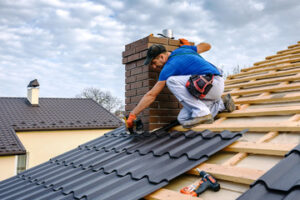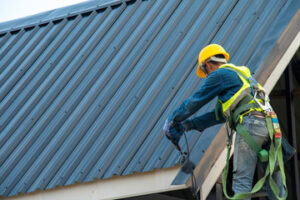A roofing contractor can provide recommendations based on your budget, goals and architecture. They will inspect your home and assess damage, then order materials.
They will install underlayment to add an extra layer of protection against moisture and leaks. They will also install flashing around chimneys, vents, and skylights. Visit fivestarroofingandcontracting.com to learn more.

The underlayment of a roofing system is an essential element of the overall roof installation. It acts as a barrier between the roof deck and other materials that aren’t water-resistant, protecting against moisture infiltration. Depending on the type of underlayment, it can also add thermal insulation and enhance energy efficiency, helping to lower your home’s cooling costs during summer and heating costs during winter.
When it comes to choosing the right underlayment, it’s important to consult with roofing professionals or follow local building codes and manufacturer recommendations for the most effective protection. Climate conditions are also an important consideration, as regions that experience frequent heavy rain or snow will require underlayment that offers superior waterproofing protection.
There are several different types of underlayment available, including felt paper, rubberized asphalt, and non-bitumen synthetic underlayment. Felt paper, commonly referred to as tar paper, is a traditional option that’s cost-effective and offers basic water resistance. It’s typically available in various thicknesses, with thirty-pound asphalt-saturated felt being the most common choice. Rubberized asphalt underlayment is thicker and offers a more durable layer of protection than felt, while non-bitumen synthetic underlayment is a lightweight, water-resistant material that’s resistant to fungal growth.
Regardless of the underlayment you choose, it’s important to start at the lowest point of the roof and carefully lay the first row horizontally along the eaves. It’s then necessary to overlap subsequent rows as recommended by the manufacturer, ensuring an adequate amount of coverage to safeguard against moisture infiltration.
While laying underlayment, it’s crucial to keep your tools clean to avoid the risk of damaging the surface of the roof. It’s best to use a tape measure to obtain accurate measurements and sketch a rough diagram to help visualize the layout of your work. When it comes time to cut the underlayment, you’ll want to use a sharp utility knife for clean cuts and minimal waste. The underlayment should be cut to a size that’s easy for you to handle and lay flat without wrinkles. A straight edge is a valuable tool for this process as well.
Shingles
The shingles that you choose for your roof can have a major impact on its appearance and durability. There are many options available, including asphalt shingles, wood shingles, and composite shingles. The choice you make depends on the look you want, as well as the climate in your area and your budget.
An experienced roofing contractor can help you decide what type of shingle is best for your home. In addition, a professional can also provide you with the financing you need to get the roofing of your dreams.
When it comes to shingles, the most popular type is an asphalt shingle. These shingles are relatively inexpensive, easy to install, and have a lifespan of up to 30 years. They can even be installed over existing shingles if the roof deck is strong enough and there’s only one layer of existing shingles, saving you money on the cost of removing the old roofing material.
Another popular type of shingle is a dimensional or architectural shingle, which are thicker and offer a more distinctive look. These shingles have two layers of shingle material that are bonded together, creating a more three-dimensional appearance. They are more expensive than 3-tab shingles, but they also last longer and are more resistant to damage from the elements.
Wooden shingles are an eco-friendly option that offer a unique, natural appearance. They’re made from recycled materials and are considered sustainable, and they can be a great alternative to a synthetic or metal roof. Wooden shingles require more maintenance, but they can last for up to 50 years.
Composite shingles are made from a combination of materials and designed to imitate the look of more expensive roofing materials, such as slate or wood. These shingles are durable and affordable, and they can help lower your energy bills. They are also fire resistant, which can save you on insurance premiums, if your policy offers it.
To ensure a long-lasting, watertight shingle roof, it’s important to choose the right shingles and have them installed correctly. Make sure to prioritize safety throughout the roofing process by wearing appropriate protective equipment and following all safety guidelines outlined by the manufacturer. It’s also a good idea to have your roof professionally inspected after installation, to ensure that all the necessary steps have been taken to prevent leaks or other problems.
Flashing
A top-tier roofer will carefully install the flashing that is needed to protect certain points of a roof. The flashing is a thin, metal material that prevents water from seeping into joints and seams. It is strategically placed around certain spots on a roof like chimneys, vents and skylights as well as at roof edges. It also helps to seal the area around these types of structures and directs water away from these areas.
Prevents Water Leaks
Flashing is one of the most important elements of a roof, especially when it comes to preventing leaks. Without the proper flashing in place, water can enter cracks and gaps in the seams and joints of a roof and cause serious damage to interior ceilings, walls, insulation, and other structures. The waterproofing and moisture-resistant properties of flashing ensure that water is not able to seep into these vulnerable spots.
Preserves Roof Longevity
Properly installed flashing prevents structural damage from water-related issues and extends the life of the roofing materials. This can save you a lot of money in the long run because you won’t have to replace your roof as soon as it starts to show signs of age and wear.
There are a variety of different types of flashing, each serving a specific purpose. There are roof flashings, wall flashings and even step flashing. Wall flashings are designed to fit over the slopes created by dormer windows and roof walls. They are typically made of metal or other durable materials that can withstand harsh weather conditions. They are also designed to collect water that penetrates the exterior of a building through these cracks and then direct it to designated drainage areas.
Vent pipe flashing is another type of flashing that is used to seal the area around plumbing vent pipes that protrude through a roof. These are often affixed to the underside of a roof and can be quite difficult to reach and inspect, but they are essential for maintaining a roof’s integrity.
The last type of flashing is called eave flashing and it is a small strip of metal that is installed at the edge of a roof. This is often the most vulnerable spot of a roof, particularly in older homes, so it is important to have it properly sealed and protected with high-quality flashing.
Ventilation
A ventilation system is necessary to ensure a continuous exchange of air in a building. Ventilation can help to improve indoor air quality by diluting metabolic pollutants (carbon dioxide and odours) and reducing moisture within the structure. It can also be used to provide oxygen for combustion and assist in cooling.
During the roofing installation process, roofers will protect eaves with drip edge flashing, roof valleys with roof valley flashing and along chimneys, wood stove pipes and certain vents with ice and water sheathing. Flashing is also used around skylights and hip roofs.
Proper ventilation prevents moisture problems like mold and rot in the attic space. It can also reduce energy costs by preventing heat buildup in the summer. A professional roofing contractor will install the appropriate venting based on the design of your attic and roof.
After the roofing job is complete, a final inspection should be conducted to ensure that sheathing is securely fastened, shingles/tiles are properly attached and that all flashing, sealants and vents are installed according to manufacturer and industry standards. In addition, a comprehensive site safety inspection should be done to ensure that nails and debris are removed from the work area and disposed of properly.
